The group of Karl Deisseroth at Stanford University pioneered the development of cation-conducting channelrhodopsins as optogenetic tools, enabling detailed investigations into neurobiology in vivo. More recently, naturally-occurring anion channelrhodopsins (nACRs) and designed anion channelrhodopsins (dACRs) have provided a powerful new way to reversibly silence neuronal activity and analyze the functions of specific neuronal circuits for animal behavior. However, nACRs and dACRs have advantages and disadvantages, and the molecular and structural understanding of both dACRs and nACRs are critical to further improve and extend inhibitory optogenetics tools. The groups Deisseroth and Brian Kobilka at Stanford University and collaborators determined crystal structures of dACR and iC++ at two different pH levels. The resulting series of structural, spectroscopic, electrophysiological, and computational analyses provided molecular insights into iC++ pH-dependence, substrate recognition, channel gating, and ion-selectivity. Moreover, structural comparison between iC++ and an nACR, GtACR1, enabled the design and creation of the first ACR (called FLASH) integrating the key features of both iC++ and GtACR1, which exhibited large photocurrent magnitude, fast kinetics, and exclusive anion selectivity.
 |
Figure: Integration of both nACR (GtACR1, left) and dACR (iC++, right). |
Citation: Kato, HE, Kim YS, Paggi, JM, Evans, KE, Allen, WE, Richardson, C, Inoue, K, Ito, S, Ramakrishnan, C, Fenno, LE, Yamashita, K, Hilger, D, Lee, SY, Berndt, A, Shen, K, Kandori, K, Dror, RO, Kobilka, BK, Deisseroth K., Structural mechanisms of selectivity and gating in anion channelrhodopsins, Nature 561, 349-354 (2018). DOI: 10.1038/s41586-018-0504-5.